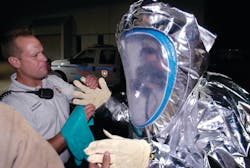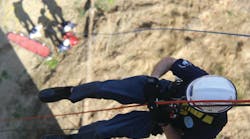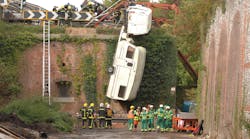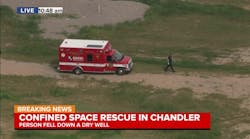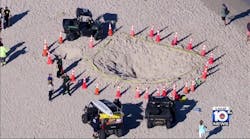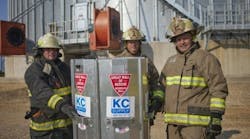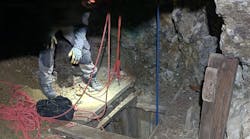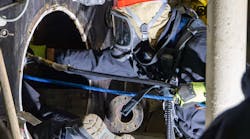By this time in a team’s development many questions have been asked and answered – team members have been assembled; training has begun; and the initial wave of equipment has been procured. With all of these resources in place, you now have to have a means to manage all of these new resources.
Phase 4 – Development of Policies and Procedures
Standard Operating Procedures (SOPs) provide guidance for most emergency response systems. Fire, EMS and law enforcement operate with the assistance of SOPs to provide direction especially in the area of safety for all of their members. Without a structured system to follow, a team’s efficiency will be challenged at every phase of its existence.
Many publications promote the development of two types of SOPs: administrative and operational. Once created, each of these segments can be joined together in one manual. If the technical rescue team is a part of an existing agency or department, their SOPs should also be included in the agencies SOPs.
The administrative SOPs will address the personnel component of a team, while the operational SOPs will provide guidance for the tactical activities a team will undertake.
There are many well-developed procedures already in existence. Begin your process by obtaining a number of existing SOPs and read through them to get a feel for what the focus areas are for your program. You can look online or contact other teams in your region to obtain these materials. When you assemble this information try to focus on team types and sizes similar to your organization.
Another point to remember; these SOPs are dynamic documents that will require continual review and updating as you move into the future. As a part of your SOP, you may be well served to include a formal review schedule so that they do not become outdated and inefficient due to the lack of attention needed to keep them current.
Many times short staffing becomes the reason for these lapses to occur; if your team ends up in that short-staffed category, you will need these SOPs even more to keep your operations viable when needed by others.
The financial support that your team requires usually comes from local funding or one or more of the various targeted grants that are available; SOPs may be a requirement for eligibility of these funds too.
Administrative SOPs – as mentioned earlier these SOPs address the personnel component of a team. Some of the various components that make up an administrative SOP include:
- Chain of Command – All organizations require some form of structure. The type (l, ll, lll) or size of a team or task force will impact the levels of command within a team. A small, single-discipline team may only have a leader, safety officer and a few rescue specialists; where a fully staffed Type 1 USAR team may have more than 100 members when you take into consideration multiple people in each individual position.
- A typical Type 1 USAR team will have the following structure:
- Team Leader/Deputy Team Leader
- Safety officer (2)
- Team Managers and their specialist components
- Search Team (2)
- Canine Search Specialist (4)
- Technical Search Specialist (2)
- Rescue Team (2)
- Rescue Squads (4 officers & 20 Rescue Specialists)
- Heavy Equipment Rigging Specialists (2)
- Hazmat Team (2)
- Hazmat Specialists (8)
- Medical Team (2)
- Medical Specialists (4)
- Logistics Team (2)
- Logistics Specialists (4)
- Communications Specialists (2)
- Support Specialists (Up to 10 drivers) (Up to 30 non-deployable support)
- Planning Team (2)
- Structural Specialists (2)
- Technical Information Specialists (2)
- Search Team (2)
- Team Leader/Deputy Team Leader
- A typical Type 1 USAR team will have the following structure:
Developing a deep bench in all positions is a big part of your ability to sustain operations over time.
Certification Requirements – Identification of the types of specialties and the associated levels of capability are two questions you must answer. Specialties related to technical rescue include: rope, confined space, collapse, trench and water (swift/ice/surf) rescue operations. Technical rescue teams can be versed in one or multiple specialties. No matter how many specialties you take on, you will need to train and maintain the required skills in all of the chosen disciplines.
Following the National Fire Protection Association (NFPA) standards will provide for three levels of preparedness: awareness, operations and technician. Check your state or local training agencies for guidance as to how your local system is designed. Some states break the various levels down into smaller programs to accommodate the large volume of information required to reach the different levels of certification.
Having your objectives listed and identified will provide a guide for the initial and continuing training requirements for your team.
Equipment Requirements – Technical rescue operations are very equipment dependent. To successfully meet your operational objective a team has to have a system to account for, maintain and deploy your assets. Maintenance schedules will ensure your equipment is ready for you at all times. Inventories of the total cache and identification of how and where each item is stored is also critical to your team’s success.
The logistics component of a team is typically responsible for the care, maintenance and distribution of your team’s equipment during training and actual deployments. During you initial team staffing, it is imperative that you do not overlook the logistic section. Without a strong support system you team will not be able to provide the level of service needed at an incident.
Many different methods of transporting your cache of equipment exist; during the Phase 2 – Planning segment (in the October edition), you most likely addressed the type of vehicles your team will utilize. Your SOPs should provide guidance on how your chosen method of transport will function within your team.
A few examples of this guidance will include:
- Motorized vehicles:
- Who is authorized to drive them?
- What is the required training as a driver?
- Are special licenses required for any of your vehicles?
- Vehicle check lists
- Maintenance schedules and responsibilities
- Trailers:
- What vehicles will be utilized to tow them?
- Will the tow vehicles be dedicated to your team or are they a shared resource?
- Who is authorized to operate the tow vehicles?
Unit Staffing – various incidents will require different numbers of responders. Many teams will utilize a tiered response formula. This format allows a requesting jurisdiction the flexibility to obtain the level of assistance needed for a specific event. Communities with hazardous materials teams are typically familiar with this type of a response system.
This is an example of the system we utilize in my home community:
Level 0 – this response provides technical support and a team leader and/or deputy team leader who will respond when requested. Depending on the specialty within the technical rescue field the response of one of the specialty team managers may also take place.
Level 1 – technical assistance will be accompanied by a small contingency of rescue specialists and overhead members. The number of members responding can vary on an incident by incident basis. A logistics component will also be activated with the response of one or more of the team’s vehicles. When equipment is requested it is imperative that the logistics support be dispatched as well. The logistic component not only controls the check out and check in of equipment, they can also assist in the monitoring of how and what the requested equipment is being utilized for.
Level 2 – this is a full activation of the team, which will bring multiple components to the scene. The activation of the command and general staff of your team will provide the following assistance to the incident commander:
- Direction of the rescue operations
- A safety officer for the technical rescue activities
- A team member assigned as a liaison to the requesting agency.
A full activation does not necessarily mean every member responds. We must remember that many of these large-scale technical rescue incidents have multiple operational periods. Having replacements in place for these situations is a sign of a well-designed and staffed team.
Level 3 – this is a special response for our team as it reflects a deployment outside of our home region for a major incident or event. The most typical responses of this nature in our part of the country are for flooding situations from multiple types of weather events. The framework for activations of this level will be a part of both the administrative and operational SOPs.
Operational SOPs – these SOPs focus on the tactical component of a team’s function.
It includes the actual types of incidents the team is prepared to respond to. The various specialties may be broken down by type as each will have their own unique operational requirements.
Most agencies utilize an incident command structure. Your technical rescue team should be a formal part of this structure. One of the greatest advantages of the incident command system is the ability to be flexible in its applications to meet the needs of the specific incident you are working. Many times the technical rescue team operates as a branch of the operations section; this allows the incident commander to retain overall incident control while utilizing the best-trained people on scene to oversee the technical rescue operations.
Many of the specialties are impacted by local, state and Federal standards that must be followed. By making these regulations a part of your SOPs, you will lessen the potential of working outside of your scope of ability.
Tactical worksheets and ICS forms are an important part of this process. You may chose to develop your own or utilize ones that other teams or agencies have developed. During multi-operational events, the documentation you create not only helps to get the most out of your people, it is also invaluable when you are requesting post-incident reimbursements for your operations expenses.
As mentioned in the administrative SOP section, team activations are a very complex operation. Your operational SOPs for a team’s activation should include: an activation plan; rally points (staging areas); equipment accountability; riding lists; personnel accountability, which includes family notification information; and a multitude of other items that need to be in place prior to your members deploying away from home.
Conclusion
Both the administrative and operational SOPs are dynamic documents that require ongoing review and updates. A good program will do a full review at least annually while making regular updates as they take place throughout the year.
This segment only touched on a small percentage of the requirements that exist for keeping your team operationally ready and maintaining the documents needed for your team. Starting a team is actually the easy part; maintaining and sustaining it is your greatest challenge.
Part 5 of this series will provide an overview of the Recourse Typing System and how it impacts your team.
BOB DUEMMEL is the technical rescue editor for Firehouse Magazine and Firehouse.com. He is also the deputy coordinator for Special Operations in Monroe County, N.Y. and a captain with the City of Rochester Fire Department. He is the Plans Manager for New York Task Force-2 USAR Team, a member of the Western New York Incident Management Team and a member of the New York State Technical Rescue curriculum development team. He is a nationally certified instructor with a focus on technical rescue programs. He has delivered training to fire service, industrial, military and international rescue teams and has assisted with exercise evaluation for the United Kingdom and the European Union's USAR program. Bob has also participated in numerous USAR exercised as both a participant and evaluator. He is host of “The Buzz on Technical Rescue” podcast. Bob can be reached at [email protected].
